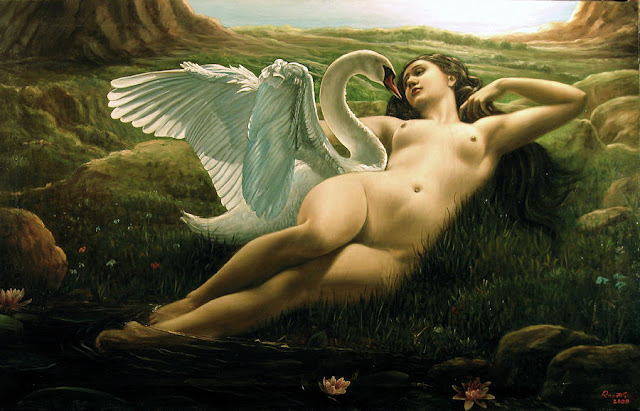SOME say that when
Zeus fell in love with
Nemesis, she fled from him into the water and became a fish; he pursued her as a beaver, ploughing up the waves. She leaped ashore, and transformed herself into this wild beast or that, but could not shake
Zeus off, because he borrowed the form of even fiercer and swifter beasts. At last she took to the air as a wild goose; he became a swan, and trod her triumphantly at Rhamnus in Attica.
Nemesis shook her feathers resignedly, and carried to Sparta, where Leda, wife of King
Tyndareus, presently found hyacinth-coloured egg lying in a marsh, which she brought home and hid in a chest: from it
Helen of Troy was hatched. But some say that this egg dropped from the moon, like the egg that, in ancient times plunged into the river Euphrates and, being towed ashore by fish and hatched by doves, broke open to reveal the Syrian Goddess of Love.
b.
Others say that
Zeus, pretending to be a swan pursued by an eagle took refuge in Nemesis’s bosom, where he ravished her and that, in due process of time, she laid an egg, which
Hermes threw between Leda’s thighs, as she sat on a stool with her legs apart. Thus Leda gave birth to Helen, and
Zeus placed the images of Swan and Eagle in the Heavens to commemorate this ruse.
c.
The most usual account, however, is that it was Leda herself with whom Zeus companied in the form of a swan beside the river Eurot: that she laid an egg from which were hatched Helen, Castor, and Polydeuces; and that she was consequently deified as the goddess Nemesis. Now, Leda’s husband Tyndareus had also lain with her the same night and, though some hold that all these three were Zeus’s children-and Clytaemnestra too, who had been hatched, with Helen, from a second egg-others record that Helen alone was a daughter of Zeus, and that Castor and Polydeuces were Tyndareus’s sons; some others again, that Castor and Clytaemnestra were children of Tyndareus, while Helen and Polydeuces were children of Zeus.
***
1.
Nemesis was the Moon-goddess as Nymph and, in the earliest form of the love-chase myth, she pursued the sacred king through his seasonal changes of hare, fish, bee, and mouse-or hare, fish, bird, and grain of wheat-and finally devoured him. With the victory of the patriarchal system, the chase was reversed: the goddess now fled from Zeus, as in the English ballad of the Coal-black Smith. She had changed into an otter or beaver to pursue the fish, and Castor’s name (‘beaver’) is clearly a survival of this myth, whereas that of Polydeuces (‘much sweet wine’) records the character of the festivities during which the chase took place.
2.
Lada is said to be the Lycian (i.e. Cretan) word for ‘woman’, and Leda was the goddess Latona, or Leto, or Lat, who bore Apollo and Artemis at Delos. The hyacinth-coloured egg recalls the blood-red Easter egg of the Druids, called the glain, for which they searched every year by the seashore; in Celtic myth it was laid by the goddess as sea-serpent. The story of its being thrown between Leda’s thighs may have been deduced from a picture of the goddess seated on the birth-stool, with Apollo’s head protruding from her womb.
3.
Helen[a] and Helle, or
Selene, are local variants of the Moon-goddess, whose identity with Lucian’s Syrian goddess is emphasized by Hyginus. But Hyginus’s account is confused: it was the goddess herself who laid the world-egg after coupling with the serpent Ophion, and who hatched it on the waters, adopting the form of a dove. She herself rose from the Void. Helen had two temples near Sparta: one at Therapnae, built on a Mycenaean site; another at Dendra, connected with a tree cult, as her Rhodian shrine also was. Pollux mentions a Spartan festival called the Helenephoria, closely resembling Athene’s Thesmophoria at Athens, during which certain unmentionable objects were carried in a special basket called a helene; such a basket Helen herself carries in reliefs showing her accompanied by the Dioscuri. The objects may have been phallic emblems; she was an orgiastic goddess.
4.
Zeus tricked Nemesis, the goddess of the Peloponnesian swan cult, by appealing to her pity, exactly as he had tricked
Hera of the Cretan cuckoo cult. This myth refers, it seems, to the arrival at Cretan or Pelasgian cities of Hellenic warriors who, to begin with, paid homage to the Great Goddess and provided her priestesses with obedient consorts, but eventually wrested the supreme sovereignty from her.


Comments
Post a Comment